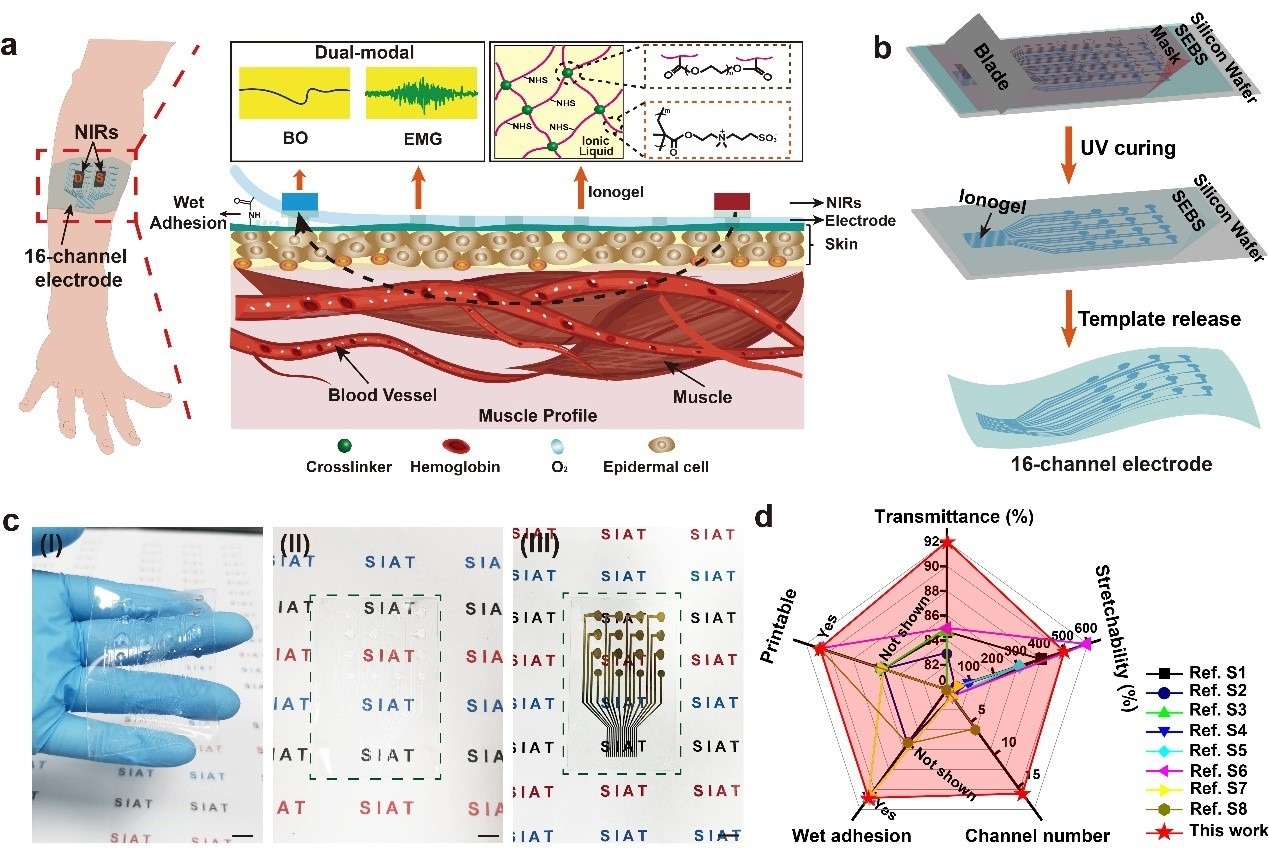In-situ dual-modal detection of electrophysiology and blood oxygen levels during muscle-vascular activity necessitates an integrated monitoring system. This system includes a transparent electrode for electrophysiology detection that is directly affixed to the skin, coupled with a near-infrared spectroscopy (NIRs) layer for blood oxygen monitoring.

Schematic illustration of stretchable multi-channel ionotronic electrodes for in-situ dual-modal monitoring of muscle-vascular activity. Image Credit: SIAT
Prior studies have successfully employed stretchable ionogels for single-channel electrophysiology monitoring. However, the achievement of in-situ dual-modal monitoring for both electrophysiology and blood oxygen using a soft and stretchable patch has remained a challenge.
A research team, under the leadership of Qiong Tian and Prof. Zhiyuan Liu at the Shenzhen Institute of Advanced Technology, Chinese Academy of Sciences, has now developed a groundbreaking solution. They have created transparent, stretchable, and skin-adherent multi-channel ionotronic electrodes, seamlessly integrating them with NIRs probes. This innovation allows for the in-situ dual-modal monitoring of muscle-vascular activity.
The research was published on September 26, 2023, in the Advanced Functional Materials.
The production of remarkably transparent 16-channel ionotronics entails a specific process. This process involves scraping, printing, and UV curing of a newly developed anhydrous ionogel. To create the ionogel, functional monomers were UV-crosslinked, forming a foundational network structure that absorbed ionic liquid.
This resulting ionogel exhibited outstanding characteristics such as softness, high stretchability, robust wet-adhesion, stable contact impedance, and exceptional transparency. Adherence to the epidermis was achieved through the incorporation of N-hydroxysuccinimide groups, which established a chemical bond with the amino group (-NH2) present on the skin surface.
These characteristics provide the electrode with resistance to sweat, allowing for extended monitoring of electromyography and electrocardiography. Moreover, ionogels are useful for monitoring electroencephalographic (EEG) signals.
In contrast to Ag/AgCl hydrogel electrodes, ionogels maintain consistent adhesion to the skin even in the presence of sweat. This ensures the successful monitoring of electrooculogram (EOG) signals during eye movement and the monitoring of alpha waves on the forehead.
In contrast to thin-film stretchable gold electrodes, our transparent ionotronic electrodes display minimal interference with NIRs sensing, performing comparably to a condition where the skin is bare. This enables precise detection of blood oxygen levels.
Zhiyuan Liu, Professor, Shenzhen Institute of Advanced Technology, Chinese Academy of Sciences
With the use of the transparent ionotronic electrode, there is a noticeable real-time negative correlation between the intensity of electrophysiology and blood oxygen levels as muscle fatigue progresses.
Journal Reference
Zhao, H., et al. (2023). Stretchable Multi‐Channel Ionotronic Electrodes for In Situ Dual‐Modal Monitoring of Muscle–Vascular Activity. Advanced Functional Materials. doi.org/10.1002/adfm.202308686.